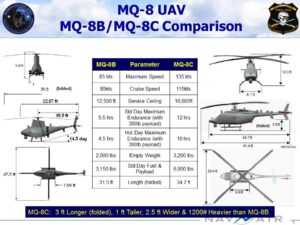Fire Scout makes it look easy to take off from a destroyer. It’s not.
In video released today (above), the MQ-8C helicopter takes off from the destroyer Jason Dunham with its eyes closed — or rather with its cockpit windows painted over, because there’s nobody inside. Though derived from the widespread Bell 407, the Northrop Grumman MQ-8C is a drone. This month’s tests are the first time the unmanned helicopter has taken off from a Navy ship at sea, and the first time any unmanned helicopter of any kind has taken off from a destroyer. The earlier MQ-8B version of the Fire Scout has already seen service on Navy frigates and Littoral Combat Ships, but the C-model is a much bigger aircraft and the Jason Dunham is a much bigger vessel.

The smaller MQ-8B Fire Scout operating off a Navy frigate.
Launching from and landing on a ship is “the most challenging [flight] regime for a naval helicopter,” said Capt. Jeff Dodge, the Fire Scout program manager at the Naval Air Systems Command (NAVAIR). “The deck is moving, the wind is turbulent — it’s really hard to replicate that on land.”
Aircraft carriers are notoriously nightmarish to touch down on: Navy fighter pilots actually show higher stress levels in night landings than in combat, though the Navy’s taught an unmanned jet to do the job. But carriers have a big, flat deck to land on and a big, deep hull to keep them from rolling too much. Destroyers like the Dunham are much smaller, so they’re less stable and can only accommodate a helipad. What’s more, unlike the streamlined control tower (or “island”) mounted on one side of a carrier’s vast flight deck, a destroyer’s complex superstructure dominates its deck and creates unpredictable turbulence in the air passing over it, what’s called the ship’s “air wake.”

The older, smaller MQ-8B Fire Scout vs. the new and larger MQ-8C
Simulations are helpful, but, to quote one 2012 paper on the topic, “current computational methods are insufficiently validated for ships with a complex superstructure, such as a destroyer or cruiser” (i.e. opposed to a flattop). In other words, our current computer models can’t capture the chaotic interaction between most warships’ air wakes and a helicopter. That means real-life at-sea testing like the Fire Scout’s aboard the Dunham is essential — and you never really know how it will go until you actually do it.
In this case, Fire Scout did well: The take-off and landing on the video are the first of 22.
A note: The Jason Dunham is named in honor of a young Marine who died throwing himself on a grenade on Iraq, saving his comrades. He was awarded a posthumous Congressional Medal of Honor. I once had the honor to interview many of his fellow Marines. It’s good to see his ship at the cutting edge of Navy innovation.
Lockheed Martin projects potential $1 billion loss on classified program
Lockheed CFO Jay Malave said the company currently expects the program to become profitable on an annual basis around the 2028 timeframe.


























